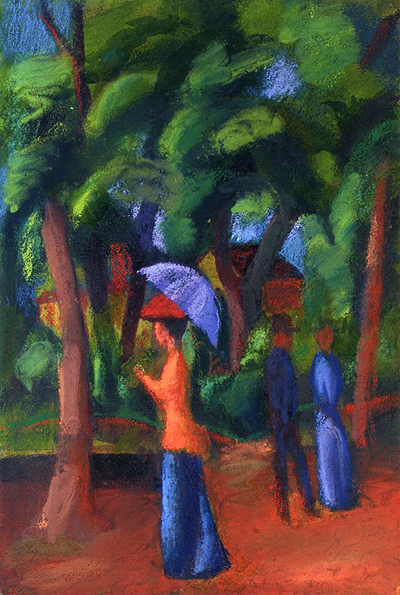Walking in the Park is dated at 1914, which tragically is the year of the artist's passing during WWI.
The painting captures a single female in the foreground, having a relaxed stroll to the left of the scene. She sports a long blue dress with a short red jacket over the top. She also wears a dark red hat and sits below a delicate blue umbrella. In the background we see a couple strolling in the other direction and then a plethora of trees which fill the rest of the canvas. Macke used a consistent tone of reddish brown to construct the ground part of his forest scenes, and sometimes it can be difficult to differentiate between his park and forest settings. Macke uses similar content in Sunny Way and Woman in Park.
Macke combined nature and humanity in many of his paintings, aiming to achieve an atmosphere of calm and happiness at a time when Europe was in political turmoil. Many times he would produce figurative pieces from within city parks, which offered an accessible opportunity to put these scenes together without too much planning being needed. The majority of his paintings were upbeat both in the bright colour schemes but also in the way that they depicted local people enjoying their leisure time, which was not something that many could do just a century or so earlier. He used his art to reflect how he saw society changing, but always portrayed it in a positive light.
Germany owes a debt of gratitude to artists such as Macke, Kirchner and Kandinsky who left behind a big impact on the direction of this nation's art. Macke was especially involved in the theories and delivery of colour within art, generally choosing a bright and positive style to his work which still feels fresh around a century later. He also took time to capture society at that time, giving his work a type of historical importance and allowing academics to get a visual understanding of life in German cities at that time. Artworks such as Woman in a Green Jacket are a good example of how he combined nature and humanity.




